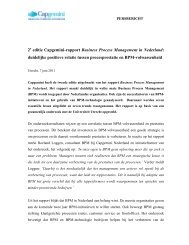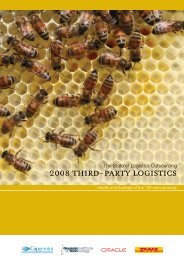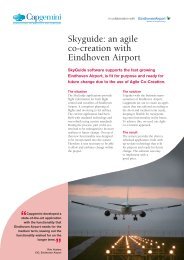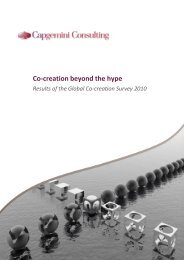IT transformations - Capgemini Consulting Nederland
IT transformations - Capgemini Consulting Nederland
IT transformations - Capgemini Consulting Nederland
You also want an ePaper? Increase the reach of your titles
YUMPU automatically turns print PDFs into web optimized ePapers that Google loves.
Locate the bottleneck<br />
Companies should focus on<br />
identifying who calls the shots in<br />
the industry, and why. They should<br />
understand what drives value creation<br />
in the sector, and who captures value.<br />
What is the logic with which the<br />
sector is structured? What business<br />
models, within the context of their<br />
architecture, appear to be making<br />
more, and why? Executives should<br />
also explore whether there is a<br />
bottleneck and, if there is, how it can<br />
be maintained.<br />
Identify how the industry<br />
architecture could change<br />
Companies should figure out whether<br />
the current division of labor in<br />
the industry could change – and<br />
if it can, how? They will need to<br />
understand what new technologies or<br />
regulations could change the sector,<br />
and, consequently, who would gain<br />
the most as a result. They should also<br />
keep an eye out for potential new<br />
entrants as the industry evolves, and<br />
how that might affect the sector’s<br />
dynamics.<br />
Identify the impact of change in<br />
industry architecture<br />
Companies need to identify how the<br />
bottleneck and the value of current<br />
players might change as a result of<br />
industry architecture changes. Key<br />
questions to consider include the<br />
direction in which the bottleneck<br />
could potentially move and the<br />
subsequent impact on existing<br />
companies.<br />
Identify how to change current role<br />
and become the bottleneck<br />
Companies need to consider what<br />
sector conventions they could change<br />
to become more effective. They<br />
will need to identify their “desired<br />
architecture” and how to achieve<br />
it. They should consider forming<br />
alliances depending on the objectives<br />
of other participants in the sector.<br />
This five-pronged analysis will deliver<br />
a vision of how a specific sector is<br />
changing, where a company currently<br />
stands, and what its future role<br />
should be. It also provides a game<br />
plan of short-term objectives to satisfy<br />
both customers and employees, as<br />
well as medium-term objectives in<br />
changing the rules of the game.<br />
The next step involves convincing<br />
people, inside and outside the<br />
organization, to accept the company’s<br />
vision.<br />
Make architectural thinking part of<br />
the organization’s fabric<br />
As well as creating and sharing a<br />
sense of the sector’s rules and roles,<br />
organizations must also be able<br />
to update their plans as the sector<br />
evolves, by instilling in management<br />
the skill to be proactive in seeking<br />
new opportunities. To do so, the<br />
right behaviors, skills, and attitudes<br />
must be promoted at manager and<br />
employee level.<br />
Have a vision of the company’s role<br />
in the sector<br />
Employees and managers may lack<br />
a vision of how they can add value<br />
to, and connect with, others in the<br />
ecosystem. This leads to missed<br />
opportunities, sending the wrong<br />
signals or eroding the company’s<br />
relative position, and being dissonant<br />
with the narrative and image the<br />
company may want to propose.<br />
Be ready to change vision<br />
Executives sometimes lack the ability<br />
and openness to change their own<br />
views of their sector. Clinging to<br />
simple depictions of reality can prove<br />
disastrous in the long-term.<br />
Recognize that positions don’t last<br />
forever<br />
A new strategy will only last while<br />
conditions allow. Even with success,<br />
the objective is still to seek the new<br />
bottleneck. It’s important to convey<br />
the sense that advantage is temporary,<br />
“<br />
A company<br />
becomes a<br />
“bottleneck”<br />
in a sector by<br />
forging alliances,<br />
changing the<br />
rules of the game<br />
and establishing<br />
webs of<br />
dependencies<br />
”<br />
89
















